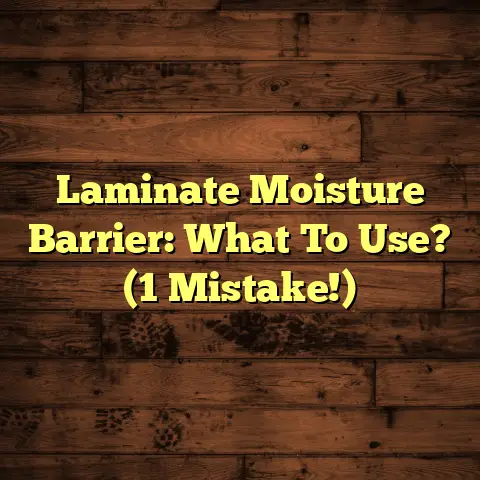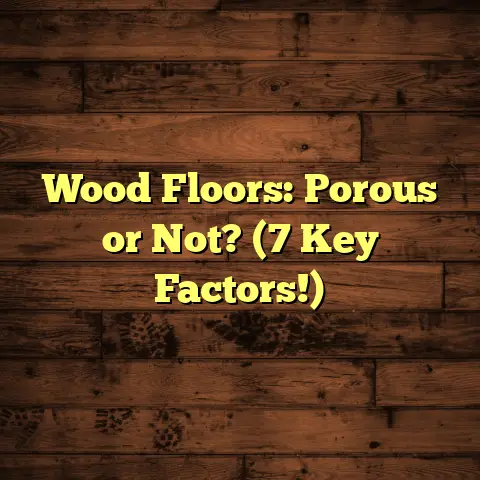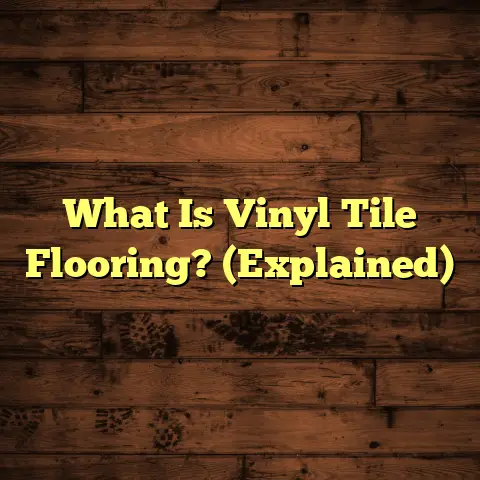Laminate Floor Issues? (5 Urgent Warning Signs!)
You know, those rich, patterned floors that seem to pull the whole room together?
Chances are, you were admiring laminate flooring.
It’s become a go-to for homeowners, and I get it!
It’s affordable, versatile, and looks fantastic.
But here’s the thing – as a flooring contractor with years of experience, I’ve seen it all.
And I can tell you, sometimes, beneath that beautiful surface, trouble is brewing.
What if your dream floors are hiding serious issues that could lead to costly repairs down the road?
That’s what I’m here to help you figure out!
Section 1: Understanding Laminate Flooring
Let’s dive into what laminate flooring actually is.
Overview of Laminate Flooring
Laminate flooring has been around for a while now, really taking off in popularity in the last few decades.
Think of it as a layered cake.
You’ve got a backing layer for stability, a core layer (usually made of high-density fiberboard or HDF), a decorative layer that gives it that wood-like or stone-like look, and finally, a tough wear layer on top.
This wear layer is super important, as it protects the floor from scratches, stains, and fading.
The beauty of laminate is that it mimics the look of more expensive materials without the hefty price tag.
Popularity and Benefits
Why do so many homeowners choose laminate? Well, there are a bunch of reasons.
First off, the cost is a big draw.
Compared to hardwood or tile, laminate is much more budget-friendly.
Installation is also a breeze, especially with click-lock systems.
I’ve seen homeowners tackle DIY projects and get great results.
Plus, the variety is endless.
You can find laminate that looks like almost any type of wood, stone, or even tile.
It’s a fantastic way to get the aesthetic you want without breaking the bank.
Section 2: The Importance of Recognizing Warning Signs
Okay, so laminate is great, but it’s not invincible.
That’s why it’s crucial to be aware of potential problems.
Why Awareness Matters
Think of your floors like your car. You wouldn’t ignore a weird noise coming from the engine, right?
The same goes for your floors.
Being vigilant about small issues can prevent them from turning into major headaches.
Ignoring a little bubbling or a tiny gap might seem harmless, but it can quickly escalate into something much worse.
The Potential Costs of Inaction
Trust me, I’ve seen it happen time and time again.
A homeowner notices a small issue but puts off dealing with it.
Then, a few months later, that small issue has become a major problem requiring extensive repairs or even a full floor replacement.
We are talking about thousands of dollars in unnecessary costs, not to mention the inconvenience of having your home disrupted.
For instance, that small water leak near the dishwasher that goes unnoticed?
It can seep under the laminate, causing the core to swell and warp.
Before you know it, you’re dealing with a floor that looks like a rollercoaster and smells like mildew.
Section 3: The 5 Urgent Warning Signs of Laminate Floor Issues
Alright, let’s get down to the nitty-gritty.
Here are five warning signs that you need to pay attention to:
Warning Sign 1: Bubbling or Warping
What is it?
Bubbling and warping are pretty easy to spot.
Bubbling looks like raised bumps or blisters on the surface of the laminate.
Warping is when the planks start to curve or lift at the edges.
What causes it?
The most common culprit is moisture.
Laminate is water-resistant but not waterproof.
If water seeps in through spills, leaks, or high humidity, the core layer can absorb it and swell.
Improper installation can also contribute to warping.
If the planks aren’t properly acclimated to the room’s temperature and humidity before installation, they can expand and contract later, leading to warping.
Why is it a problem?
Bubbling and warping are not only unsightly, but they can also be a safety hazard.
Imagine tripping over a warped plank in the middle of the night!
Plus, they indicate that the floor’s structural integrity is compromised.
Warning Sign 2: Gaps Between Planks
What is it?
Gaps are those spaces that appear between the planks of your laminate floor.
They can be small and barely noticeable or wide enough to stick a dime in.
What causes it?
Temperature and humidity changes are often to blame.
Laminate expands in heat and contracts in cold.
Poor installation is another factor.
If the planks weren’t properly locked together during installation, they can separate over time.
Why is it a problem?
Gaps are like magnets for dirt and debris.
Once dirt gets in there, it’s tough to get out, and it can scratch the surface of the surrounding planks.
Gaps also allow moisture to seep down to the subfloor, potentially causing more serious damage.
Warning Sign 3: Cracking or Chipping
What is it?
Cracks are breaks in the surface of the laminate, while chips are small pieces that have broken off.
What causes it?
Heavy foot traffic, especially in high-traffic areas, can cause wear and tear that leads to cracking or chipping.
Dropping heavy objects is another common cause.
I’ve seen floors that look like they’ve been through a war zone because someone dropped a cast iron skillet one too many times.
Why is it a problem?
Cracks and chips compromise the wear layer of the laminate, making it more susceptible to damage.
They also detract from the overall appearance of the floor.
Plus, sharp edges from cracks and chips can be a hazard, especially for kids and pets.
Warning Sign 4: Uneven Surface
What is it?
An uneven surface is when parts of your floor feel higher or lower than others.
You might notice it when walking barefoot or when furniture wobbles.
What causes it?
The most common culprit is a problem with the subfloor.
If the subfloor is uneven, damaged, or not properly prepared before installation, it can cause the laminate to buckle and create an uneven surface.
Moisture damage can also cause the subfloor to swell or rot, leading to unevenness.
Why is it a problem?
An uneven surface is not only uncomfortable to walk on, but it can also damage the laminate over time.
The constant flexing and pressure can cause the planks to crack or separate.
It can also be a sign of a more serious underlying issue, such as structural damage to the subfloor.
Warning Sign 5: Foul Odors
What is it?
A persistent, unpleasant smell coming from your floor.
It might smell musty, moldy, or just plain funky.
What causes it?
Moisture is the key here.
If water gets trapped under the laminate, it can create a breeding ground for mold and mildew.
These organisms release gases that cause foul odors.
Pet urine is another common cause.
If your furry friend has an accident on the floor, and it’s not cleaned up properly, the urine can seep into the seams and cause a lingering odor.
Why is it a problem?
Foul odors are a clear sign of mold or mildew growth, which can pose serious health risks.
Mold can trigger allergies, asthma, and other respiratory problems.
Plus, the odor itself is just unpleasant to live with.
I had one client who thought their house was haunted because of a strange smell.
Turns out, it was just mold growing under their laminate floor!
Section 4: Consequences of Ignoring Warning Signs
So, you’ve spotted one or more of these warning signs.
What happens if you ignore them?
Damage to Flooring and Home
Ignoring these issues can lead to a domino effect of damage.
The moisture that causes bubbling and warping can also rot the subfloor.
This can weaken the structural integrity of your home and lead to costly repairs.
Gaps and cracks can allow pests to enter your home, leading to infestations.
I’ve seen termite damage that started with a small crack in the laminate floor.
The longer you wait to address these issues, the more extensive and expensive the repairs will be.
Health Risks
Mold and mildew are not just bad for your home; they’re bad for your health.
Exposure to mold can cause a range of symptoms, including:
- Allergies: Sneezing, runny nose, itchy eyes
- Asthma: Wheezing, coughing, shortness of breath
- Respiratory infections: Bronchitis, pneumonia
- Skin irritation: Rashes, hives
- Headaches: Migraines, dizziness
People with weakened immune systems, young children, and the elderly are particularly vulnerable to the health effects of mold.
It’s not worth risking your health or the health of your family by ignoring these warning signs.
Section 5: Conclusion
Alright, we’ve covered a lot of ground here.
Recap the Importance of Vigilance
The key takeaway is this: Pay attention to your floors!
Regularly inspect your laminate for any signs of damage or wear.
Don’t ignore small issues, thinking they’ll go away on their own.
Being proactive can save you a lot of money and headaches in the long run.
Remember, a little bit of prevention is worth a pound of cure.
Encouragement to Act
So, what should you do if you spot one of these warning signs?
First, don’t panic!
Take a deep breath and assess the situation.
If the issue is minor, you might be able to fix it yourself.
For example, you can use a laminate repair kit to fill in small cracks or chips.
But if the issue is more serious, or if you’re not comfortable tackling it yourself, call a professional.
I always recommend getting a few different quotes and checking references before hiring a contractor.
Don’t be afraid to ask questions and get a clear understanding of the scope of the work and the cost.
Your floors are an important part of your home.
Taking care of them will not only make your home look better, but it will also protect your investment and your health.
So, go take a look at your floors right now.
Do you see any bubbling, warping, gaps, cracks, or unevenness?
Do you smell any foul odors?
If you do, don’t wait.
Take action today to protect your home and your health.
You got this! And if you need help, you know where to find me.





